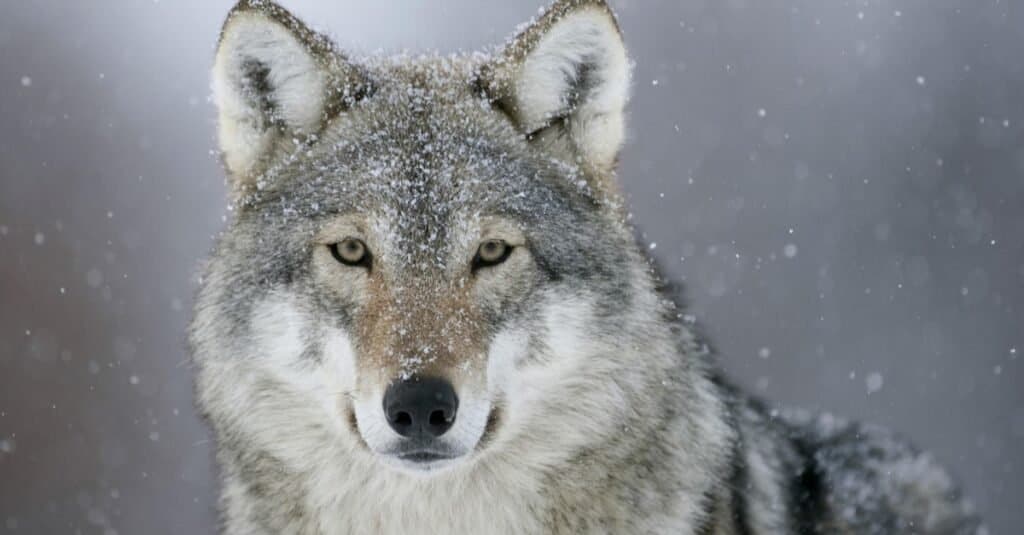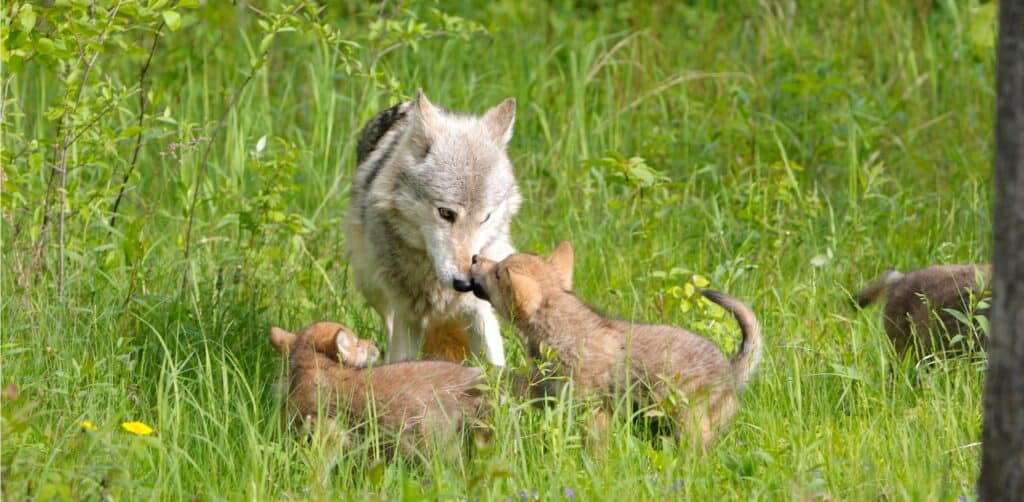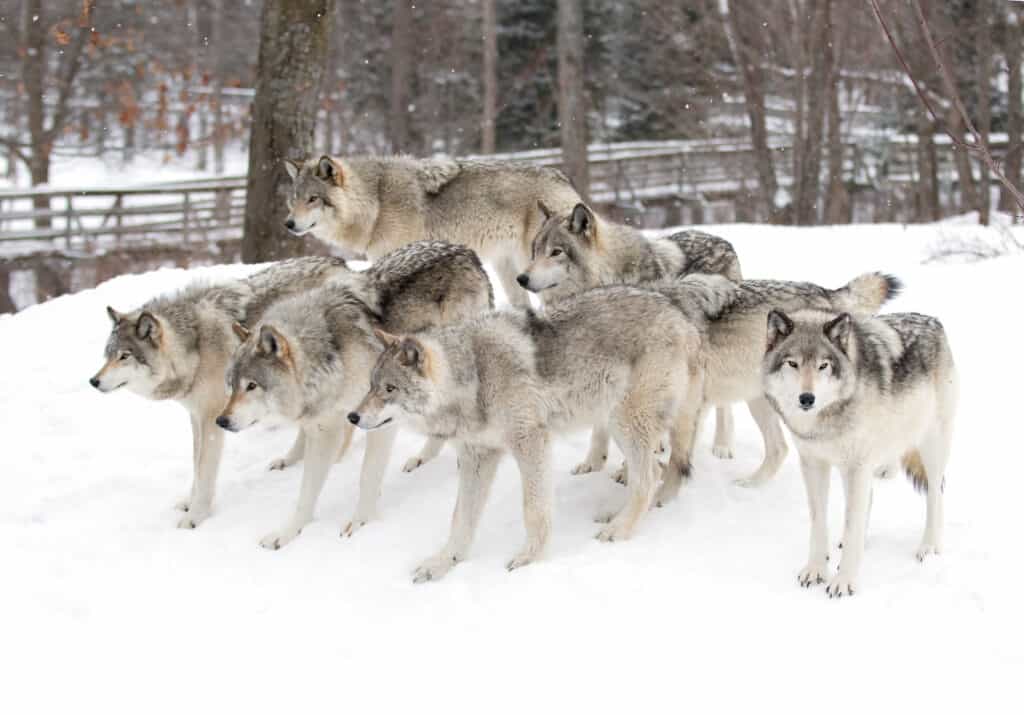Wolves are some of the most fascinating animals in the world and live in packs which are known for their strict hierarchy and social structure. Wolf packs consist of up to 20 animals and are ruled by the dominant alpha pair. However, three further ranks determine the status of the wolves and their role within the pack. These include the beta pair which is the second-in-command and the lowest-ranking omega wolf. Each of these ranks is vital to the survival of the pack and understanding their importance and role helps us to fully understand how they impact the dynamics of the pack. So, let’s explore the four wolf pack ranks and discover exactly how they work!
Alpha

The alpha wolves are the leaders of the pack and are the decision makers.
©nataliatamkovich/Shutterstock.com
The dominant wolves within the pack are the alpha wolves or alpha pair. They are the dominant male and female and are responsible for the entire pack. As the highest-ranking wolves the alpha pair always eat before the rest of the pack. The alpha wolves are the leaders and the rest of the wolves are expected to follow their direction.
Alpha Male
The alpha male is typically the largest and strongest wolf within the pack, although sometimes he may simply be the most dominant but not necessarily the largest. The alpha wolf is the decision maker and decides where the pack goes and what they do. It is also his responsibility to ensure the safety of his pack, although he may sometimes share this burden with the beta male. He is also the leader of the hunts and sourcing food is generally his responsibility, even though other wolves will go on the hunt with him. He is also the only male that will reproduce, breeding with the alpha female that he chose as his mate.
Alpha Female

The alpha female is the only one who gives birth to cubs within the pack.
©COULANGES/Shutterstock.com
The alpha female — also called the luna wolf — is again not necessarily the strongest female but attains the alpha status as the mate of the alpha wolf. She is the only female that will breed within the pack and is therefore the one that is responsible for ensuring the continued survival of the pack. Although the both the male and female have alpha status, the alpha female will always play second fiddle to the alpha male.
The alpha female is the highest-ranking female and therefore commands all of the other females. The other females look up to her and follow her directions. They rarely question her authority. The alpha female is the only wolf within the pack that gives birth to cubs so it is her job to nurture her offspring, protect them from danger, and teach them to hunt. She may also sometimes join the alpha male on hunting trips if she is not occupied with her young.
Beta
The next wolf pack rank is the beta pair. Like the alpha wolves, the beta pair consists of a male and female, although again the female plays second fiddle to the male of the same rank. The beta pair are considered to be the “second-in-command” to the alpha pair and are responsible for the lower-ranking wolves. However, in smaller packs the beta rank may not exist, with the alpha pair overseeing the entire pack directly.
As the second-highest rank in the wolf pack, beta wolves have a unique status that is just below that of the alpha wolves. They — particularly the beta male — will work closely with the alpha male. The beta male will know information that is vital to the pack’s survival, including the location of prime hunting grounds, and will often join the alpha on hunts. He is also able to take charge of the pack in his absence and to make any necessary decisions.
Although the alphas are responsible for the pack as a whole, the betas will take charge of the lower ranks and can direct them as needed. They also help to maintain order within the lower ranks, yet are ready to defend the alphas at a moment’s notice. However, if the alpha male dies then as the next ranking wolf and typically the second-most dominant male, the beta wolf will often step up into the role of alpha.
Mid-Ranking Wolves

The majority of the pack are mid-ranking wolves who hunt for food and defend the pack.
©Jim Cumming/Shutterstock.com
The majority of the remaining pack fall into the category of mid-ranking wolves. Mid-ranking wolves are also known as subordinates and will typically act submissively towards the alpha and beta pair. This involves lowering their tail, head, and ears so that they are below the level of the higher ranking wolves.
The mid-ranking wolves consist of a mixture of older wolves who may sometimes be related to the alpha wolves, and several younger wolves. The mid-ranking wolves typically participate in group hunts. They also undertake the role of defending the pack against threats and intruders. However, they will also help to care for the cubs, teaching them how to hunt and looking after them for the alpha.
Although the mid-ranking wolves usually know their place beneath the alpha and beta wolves they often establish their own hierarchy based on age, experience, and dominance. Sometimes small skirmishes and fights may break out amongst them, although they do not usually interfere with the greater structure of the pack. Once established, the hierarchy within the mid-ranking wolves also determines the order which they eat. Just like the alpha pair eats before the beta pair, the older and more respected members will eat before the younger or more submissive members of the pack.
Omega

Omega wolves are the peacemakers who diffuse tensions within the pack.
©AB Photographie/Shutterstock.com
The lowest rank in the wolf pack is that of the omega wolf. Omega wolves are the smallest and most submissive wolves in the pack. They may have been the runt of the litter so may be naturally slightly smaller and weaker than the others. Also, as they hold the lowest rank they are the last in the pack to eat, therefore getting the smallest meal which contributes to their smaller stature.
However, despite its low rank, the omega wolf actually has a very important role to play within the pack. This is because the omega wolf is typically considered to be the peacemaker. Wolves in this rank know their place and don’t strive to obtain a higher rank. They don’t pick fights with the others, but as a peacemaker, they will often help to diffuse tensions between other, more volatile members of the pack. This is usually by intervening and encouraging the other wolves to leave the fight and by providing a calming influence. If one of the other wolves then turns their attention to the omega wolf then it will not fight back as it knows its place within the pack.
Omega wolves are essential to the pack as without them it is more likely that skirmishes will break out, particularly when new members join the pack. They are the “social glue” as they help to maintain order, particularly amongst the mid-ranking wolves.
Cubs
Although wolf packs follow a system of strict hierarchy, the wolf cubs do not form part of the wolf pack ranking system until they reach the age of sexual maturity. Until sexual maturity, the cubs remain under the care of their mother (the alpha female) and any mid-ranking wolves who are enlisted to help. Sexual maturity is reached between the ages of two and three years old. Once maturity is reached they will often (although not always) leave the pack that they were born in. They typically either join an existing pack or find a mate and begin a new pack.
The photo featured at the top of this post is © Bildagentur Zoonar GmbH/Shutterstock.com
Thank you for reading! Have some feedback for us? Contact the AZ Animals editorial team.






